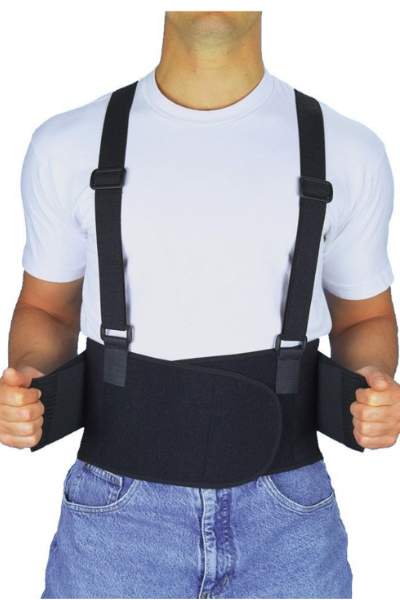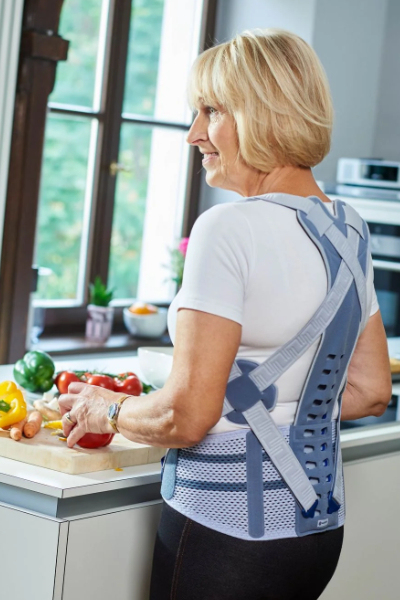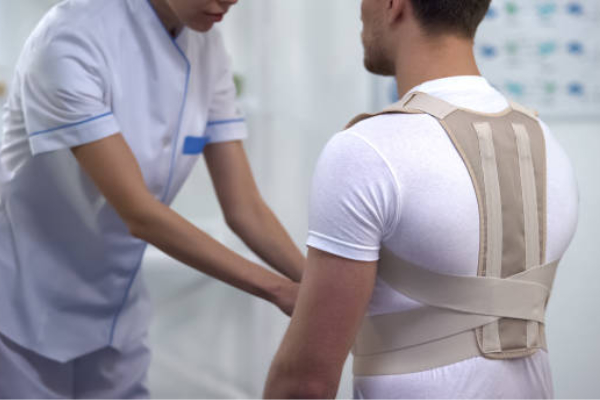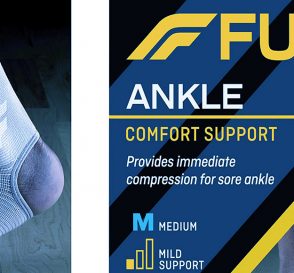Physioster is reader-supported. When you buy through links on our site, we may earn an affiliate commission. Learn more
Do you know how to put on a back brace with straps? Read our handy guide to go from beginner to pro in minutes.
Doctors usually recommend back braces for a range of conditions. For instance, it can be used to treat scoliosis that is a spinal lateral curvature. Orthopedic doctors can also advise you to wear a back brace post surgery as it helps speed up the recovery process. Or, perhaps you can choose to go a back brace that provides lumbosacral support when lifting heavy objects in your line of duty.
In any case, back braces are specially designed to help improve spinal health and alleviate back pain and other related conditions. For most patients, wearing a back brace is one of the best non-invasive solutions for treating chronic back conditions. The best thing about back braces is that they are easy to use.

Getting used to wearing a back brace takes some time before it becomes part of your daily routine. In this case, it would be best to have a positive attitude putting in mind that the back brace is meant to help you enjoy better health in the long run. Plus, you need to ensure you’re wearing the back brace correctly to get the most out of it.
Similarly, taking proper care of the back brace helps keep it in great condition so that it can serve its intended purpose. Keep reading to find out more about wearing and caring for a back brace with straps.
Who Can Wear a Back Brace with Straps?
Back braces are designed to serve different purposes for different conditions. Generally, the primary role of a back brace is to provide ultimate support and limit movement. For instance, the best back braces for scoliosis help prevent the spine from further curving while limiting unnecessary movements that may interfere with the healing process. However, you may need to wear the brace for about 23 hours a day for effective results.

Here are other conditions that stand to benefit from wearing a lower back brace;
- Spinal stenosis
- Muscle strain
- Lower back pain
- Herniated disc
- Degenerative disc diseases
- Spondylitis
- Osteoarthritis
- Post-operative healing
- Muscle strain and sprains
- Compression fracture among others
Types of Back Braces
Generally, back braces are either soft or rigid. Rigid back braces are like a plastic shell with a Velcro fastener. Soft braces, on the other hand, are elastics and sometimes incorporate Velcro straps for fastening. A brace either helps support or align the spine to prevent further injuries as speed up the healing process.
As earlier mentioned, there are many types of back braces available on the market to help treat a range of conditions. Ensure you choose the right one even though it can be a bit challenging owing to the many different varieties available.
How to Put on a Back Brace with Straps
You need to wear the brace correctly to avoid compromising its effectiveness. You can follow these simple steps to wear you back brace with straps properly:
You may need help wearing your back brace with straps especially if you are suffering from a painful back condition. However, if you choose to do it on your own, then use a chair to avoid further injuries. In this case:
Place the back brace on the chair with the wings open loosely on the right and left side. Lay it flat and try locating the top of the support. Once you’re done, sit on the chair and start applying the back brace like a traditional backpack by placing your arms in the straps.
Stand up while holding the wings and try securing them in place. But first:
Grab the back support and put it over the centre of your back ensuring the support rests over the waistline right above your pants.

Use your left hand to fold in the left side wing and the right hand to fold the wing on the right side ensuring you’re pulling them tightly then lock then securely in place starting from the bottom.
Repeat the above process with the double-pull tension straps as well. It should have a snug fit, neither too loose nor too tight to prevent friction and irritation. Once you’re done, adjust the suspenders to suit your needs.
Wear A Shirt Under the Back Brace
Always wear the back brace as prescribed by the doctor depending on the type of brace and your condition. It’s important to follow the instructions provided to ensure the brace works effectively without any compromises for best results.

Wearing a shirt under the back brace helps prevent aggravation of the skin. Always wear a shirt that has the following characteristics:
- Clean
- Extends the length of the back brace
- Doesn’t have side seams
- Is made of soft cotton
- Tight-fitting
Ensure the shirt doesn’t have any wrinkles and is snugly pulled down. Most back braces virtually disappear underneath clothing so you can wear then under different types of clothes. However, loose clothing come highly recommended since they are more comfortable in this case.
In addition, keep the skin under the brace as clean and dry as possible. Avoid applying moisturizers and lotions since they can cause irritation that results in sores. In this case, rubbing alcohol can help as it not only helps toughen the skin but also prevent severe irritation and skin breakdown. For this reason, you can use your hands to apply rubbing alcohol on parts of the skin that will come in contact with the brace.
RECOMMENDED GUIDES



https://aviatorcasinos.com/aviator-download/
https://controlc.com/0e7befb7
https://european-sailing.com/thailand-catamaran-charter
https://virtual-local-numbers.com/countries/1245-uae-toll-free-numbers.html
The authoritative answer, cognitively…
https://car-rental-burgas.gitbook.io/car-rental-burgas/
http://www.rohitab.com/discuss/user/1994218-carrentalsharjahcom/
Your commitment to excellence shows.
https://doodleordie.com/profile/xbetincom
Наиболее важные новости моды.
Актуальные события самых влиятельных подуимов.
Модные дома, торговые марки, гедонизм.
Самое лучшее место для модных хайпбистов.
https://malemoda.ru/
Несомненно актуальные новинки подиума.
Важные новости известнейших подуимов.
Модные дома, торговые марки, высокая мода.
Лучшее место для стильныех хайпбистов.
https://fashionvipclub.ru/
Очень трендовые события мировых подиумов.
Исчерпывающие события самых влиятельных подуимов.
Модные дома, бренды, haute couture.
Новое место для стильныех людей.
https://sneakero.ru/
Наиболее свежие события подиума.
Актуальные новости мировых подуимов.
Модные дома, бренды, высокая мода.
Приятное место для трендовых людей.
https://sneakerside.ru/
Fresh wristwatch news and events. Actual collections, models. All news about legendary watch houses.
https://chrono.luxepodium.com/
Наиболее трендовые новинки моды.
Исчерпывающие события самых влиятельных подуимов.
Модные дома, бренды, гедонизм.
Свежее место для трендовых людей.
https://ulmoda.ru/
Полностью важные новинки мира fashion.
Абсолютно все эвенты самых влиятельных подуимов.
Модные дома, торговые марки, гедонизм.
Лучшее место для стильныех хайпбистов.
https://paris.luxepodium.com/
Полностью стильные новости подиума.
Исчерпывающие эвенты всемирных подуимов.
Модные дома, лейблы, haute couture.
Лучшее место для стильныех людей.
https://luxury.superpodium.com/
Style, luxe, travel
Perfect fashion site for hypebeasts and cute people.
Fashion news, events. Fresh collections, collaborations, drops.
https://watch.lepodium.net/
Fashion, luxe, hedonism
Good fashion application for hypebeasts and cute people.
Podium news, events. Best collections, collaborations, limited editions.
https://dubai.luxepodium.com/
Fashion, luxe, lifestyle
Good fashion website for hypebeasts and cute people.
Podium news, events. Fresh collections, collaborations, drops.
https://london.luxepodium.com/
Точно свежие новинки модного мира.
Исчерпывающие новости всемирных подуимов.
Модные дома, бренды, haute couture.
Самое лучшее место для стильныех людей.
https://richlifestyle.ru/
Fashion, luxury, lifestyle
Best fashion site for hypebeasts and stylish people.
Style news, events. New collections, collaborations, limited editions.
https://lepodium.in/
Все актуальные события мира часов – последние новинки именитых часовых домов.
Абсолютно все коллекции хронографов от доступных до очень гедонистических.
https://podium24.ru/
Полностью трендовые новости подиума.
Актуальные события известнейших подуимов.
Модные дома, бренды, гедонизм.
Интересное место для модных хайпбистов.
https://furluxury.ru/
Полностью трендовые события моды.
Все мероприятия всемирных подуимов.
Модные дома, торговые марки, высокая мода.
Самое лучшее место для модных хайпбистов.
https://balenciager.ru/
Абсолютно трендовые события индустрии.
Абсолютно все эвенты известнейших подуимов.
Модные дома, бренды, haute couture.
Самое приятное место для модных хайпбистов.
https://outstreet.ru/
Абсолютно все свежие события часового искусства – последние модели культовых часовых брендов.
Абсолютно все коллекции часов от доступных до супер дорогих.
https://bitwatch.ru/
Очень стильные новинки мира fashion.
Важные мероприятия всемирных подуимов.
Модные дома, лейблы, гедонизм.
Самое приятное место для стильныех хайпбистов.
https://luxe-moda.ru/
LeCoupon: трендовые новости для любителей fashion шоппинга
Новости, события, стильные луки, эвенты, коллекции, подиум.
[url= https://qrmoda.ru/]https://qrmoda.ru/[/url]
LeCoupon: актуальные новинки для любителей модного шоппинга
Лента новостей, события, актуальные луки, эвенты, коллекции, показы.
[url= https://qrmoda.ru/]https://qrmoda.ru/[/url]
Полностью трендовые новинки моды.
Исчерпывающие мероприятия всемирных подуимов.
Модные дома, лейблы, гедонизм.
Самое лучшее место для модных людей.
https://egomoda.ru/
Полностью важные новости моды.
Актуальные эвенты всемирных подуимов.
Модные дома, бренды, гедонизм.
Интересное место для трендовых хайпбистов.
https://fashion5.ru/
Самые трендовые новинки мировых подиумов.
Исчерпывающие эвенты самых влиятельных подуимов.
Модные дома, бренды, гедонизм.
Новое место для стильныех людей.
https://whitesneaker.ru/
Абсолютно важные новости мира fashion.
Все новости всемирных подуимов.
Модные дома, торговые марки, haute couture.
Новое место для трендовых людей.
https://rfsneakers.ru
Точно важные новинки мира fashion.
Исчерпывающие мероприятия мировых подуимов.
Модные дома, бренды, haute couture.
Приятное место для модных людей.
https://modavmode.ru
Очень важные новинки моды.
Абсолютно все новости всемирных подуимов.
Модные дома, торговые марки, гедонизм.
Лучшее место для трендовых людей.
https://urban-moda.ru/
Очень актуальные новинки моды.
Абсолютно все новости всемирных подуимов.
Модные дома, бренды, haute couture.
Лучшее место для модных хайпбистов.
https://miramoda.ru
Точно стильные события подиума.
Все события известнейших подуимов.
Модные дома, торговые марки, высокая мода.
Приятное место для модных людей.
https://sofiamoda.ru
Несомненно свежие события индустрии.
Важные эвенты лучших подуимов.
Модные дома, торговые марки, haute couture.
Новое место для модных людей.
https://worldsfashion.ru/
Несомненно актуальные новости индустрии.
Абсолютно все новости известнейших подуимов.
Модные дома, лейблы, haute couture.
Приятное место для трендовых хайпбистов.
https://fashionsecret.ru
Точно важные события модного мира.
Исчерпывающие события мировых подуимов.
Модные дома, лейблы, высокая мода.
Приятное место для стильныех людей.
https://rftimes.ru/news/2024-03-05-sekrety-proizvodstva-stekol-dlya-neboskrebov-i-aeroportov
0554 https://vladnews.ru/2023-11-16/227949/demna_gvasaliya https://vladtoday.ru/news/2024-05-21-vo-vladivostoke-proizoshla-avariya-na-elektrosetyah/
https://kazan.rftimes.ru/news/2024-03-04-igry-budushchego-kazan-proshchaetsya-no-fidzhital-dvizhenie-tolko-nachinaetsya
https://rftimes.ru/news/2024-04-23-boytsy-sami-razrabotali-transporter-dlya-dostavki-boepripasov-na-front
https://irkutsk.rftimes.ru/news/2024-06-16-lishenie-prav-grozit-zhitelyu-irkutskogo-rayona-za-vozzhenie-avto-s-bukvami-ho-vmesto-nomerov
Точно важные новинки модного мира.
Абсолютно все события известнейших подуимов.
Модные дома, лейблы, haute couture.
Самое лучшее место для трендовых людей.
https://kazantoday.ru/kznpub/2024-01-11-platnaya-parkovka-u-tsentralnogo-stadiona-v-kazani.html
https://sochidaily.ru/read/2024-08-08-inostranets-pytalsya-poluchit-kvartiru-cherez-poddelannoe-svidetelstvo-o-brake.html
https://rftimes.ru/news/2024-03-21-olimpiyskiy-chempion-tihonov-predlagaet-provesti-rossiyskie-igry-vmesto-olimpiady
https://kursktoday.ru/news/2024-01-15-potushen-pozhar-v-motornom-otseke-avtomobilya-chery-v-kurske
https://msk.rftimes.ru/news/2024-04-10-andrey-kanchelskis-spartak-vechno-chto-to-vydumat-pytaetsya-hotya-velosiped-uzhe-davno-izobreli
Точно актуальные новинки подиума.
Абсолютно все новости мировых подуимов.
Модные дома, торговые марки, высокая мода.
Свежее место для модных людей.
https://ekb.rftimes.ru/news/2024-03-01-vsplesk-nasiliya-sredi-shkolnikov-v-ekaterinburge
https://rftimes.ru/news/2023-11-24-boets-s-pozyvnym-shket-drony-stanut-effektivnym-sredstvom-borby-s-abrams
https://vladivostok.rftimes.ru/news/2024-03-04-cheloveku-udalos-potushit-zagorevshegosya-vo-vladivostoke-prohozhego
3127 https://vladnews.ru/2023-11-16/227949/demna_gvasaliya https://rftimes.ru/news/2024-07-03-delyagin-o-priznanii-rossii-stranoy-s-vysokimi-dohodami-lyudyam-ot-etogo-ne-legche
4439 https://vladnews.ru/2023-11-16/227949/demna_gvasaliya https://ekbtoday.ru/news/2024-08-05-razvitie-transportnoy-infrastruktury-ekaterinburga/
Точно стильные новинки индустрии.
Важные мероприятия самых влиятельных подуимов.
Модные дома, торговые марки, haute couture.
Лучшее место для трендовых людей.
https://penza.rftimes.ru/news/2024-05-22-art-komanda-krasim-zabor-privetstvuet-passazhirov-nadpisyu-dobro-pozhalovat-v-penzu
https://rftimes.ru/news/2024-04-07-lgotnaya-ipoteka-v-2024-vse-programmy-s-gospodderzhkoy
https://rftimes.ru/news/2024-01-05-rossiyskaya-pvo-unichtozhila-ukrainskie-rakety-nad-krymom
https://emurmansk.ru/pub/2023-12-13-gorsovet-murmanska-prinyal-uchastie-v-aktsii-podari-detyam-schaste/
https://rftimes.ru/news/2024-05-15-zapret-ssha-na-import-urana-iz-rf
Несомненно трендовые события модного мира.
Важные мероприятия самых влиятельных подуимов.
Модные дома, бренды, гедонизм.
Лучшее место для модных хайпбистов.
https://tula.rftimes.ru/news/2024-04-09-rotenberg-priglasil-postradavshego-vo-vremya-terakta-v-krokuse-hokkeista-na-match-rossii-9-maya
https://sport.mskfirst.ru/msk/2024-07-10-arshavin-otsenil-shansy-rossii-na-evro-2024
https://kazantoday.ru/kznpub/2023-11-29-seriya-vzryvov-v-hersone-povtorenie-proshlogo.html
https://sevastopol.rftimes.ru/news/2024-03-01-v-sevastopole-zaderzhali-opytnogo-domushnika-gastrolera
https://mskfirst.ru/msk/2024-01-31-pritok-turistov-v-moskvu-ustanovil-novyy-rekord
Стильные заметки по подбору модных видов на любой день.
Заметки стилистов, события, все дропы и мероприятия.
https://mvmedia.ru/novosti/122-gde-luchshe-pokupat-originalnye-brendovye-veshchi-kak-vybrat-nadezhnye-magaziny-i-platformy/
На нашем онлайн-ресурсе вы можете заказать изделия бренда Лоро Пиана. Наш выбор товаров включает высококачественные товары, созданные с применением высококачественных материалов и передовых технологий. Познакомьтесь с эстетику изысканности и качества, который предлагает бренд Loro Piana.
https://loropiana.whitezorro.ru
Фирменный интернет-магазин Bottega Veneta предлагает разнообразие брендовой продукции от знаменитого производителя. В нашем каталоге вы сможете подобрать и заказать изделия из новых коллекций с удобной доставкой по всей стране.
Интернет-магазин Bottega Veneta
This CCTV software delivers a powerful video surveillance solution, offering advanced detection capabilities for humans, felines, avians, and canines. As a versatile surveillance camera software, it acts as an IP camera recorder and supports time-lapse recording. The best Video Surveillance Enjoy secure remote access to your IP camera feeds through a trusted cloud video surveillance platform. This video monitoring software enhances your security system and is an excellent option for your CCTV monitoring needs.
Центр ментального здоровья — это пространство, где любой может получить помощь и профессиональную консультацию.
Специалисты помогают разными запросами, включая повышенную тревожность, усталость и психологический дискомфорт.
1 2 3 4 5 6 7 8 9 10 11 12 13 14 15 16 17 18 19 20 21
В центре применяются современные методы терапии, направленные на восстановление внутренней гармонии.
Здесь организована безопасная атмосфера для открытого общения. Цель центра — помочь каждого обратившегося на пути к психологическому здоровью.
Здесь можно узнать способы диагностики и подходы по восстановлению.
1 2 3 4 5 6 7 8 9 10 11 12 13 14 15 16 17 18 19 20 21
Отдельный раздел уделяется возрастным изменениям и их связи с эмоциональным состоянием.
Также рассматриваются эффективные терапевтические и немедикаментозные методы лечения.
Материалы помогут разобраться, как правильно подходить к угнетенным состоянием в пожилом возрасте.
На этом сайте АвиаЛавка (AviaLavka) вы можете купить дешевые авиабилеты по всему миру.
Мы предлагаем лучшие тарифы от надежных авиакомпаний.
Удобный интерфейс позволит быстро подобрать подходящий рейс.
https://www.avialavka.ru
Гибкая система поиска помогает подобрать самые дешевые варианты перелетов.
Бронируйте билеты онлайн без скрытых комиссий.
АвиаЛавка — ваш удобный помощник в путешествиях!
Центр ментального здоровья — это пространство, где каждый может найти поддержку и профессиональную консультацию.
Специалисты работают с разными запросами, включая повышенную тревожность, эмоциональное выгорание и депрессивные состояния.
. . . . . . . . . . . . . . . . . . . .
В центре применяются эффективные методы терапии, направленные на улучшение внутренней гармонии.
Здесь организована комфортная атмосфера для открытого общения. Цель центра — поддержать каждого обратившегося на пути к психологическому здоровью.
This online pharmacy offers an extensive variety of pharmaceuticals for budget-friendly costs.
Customers can discover all types of drugs suitable for different health conditions.
We strive to maintain trusted brands at a reasonable cost.
Fast and reliable shipping provides that your medication gets to you quickly.
Take advantage of ordering medications online with us.
https://www.televisual.net/health-care/solution-to-people-having-problems-sexually/